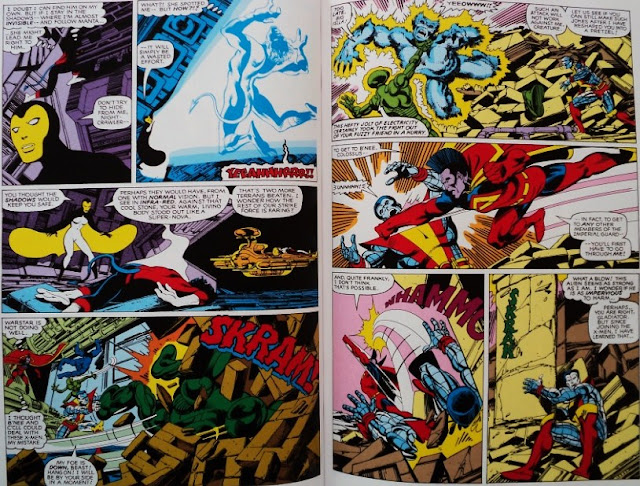Jean Grey was there since the early days. She was one of Xavier’s young pupils. She retired from the team and then she returned when she was needed. And now that she’s gone, Scott is experiencing the hardest moment of his life: “Losing you was the loss I couldn’t take. Jean, you’re everything to me -- as necessary as the air I breathe”. And thus, Cyclops decides to take a leave of absence.
In "...Something Wicked This Way Comes" (Uncanny X-Men # 139), Wolverine decides to head for Canada to straighten things up with the Canadian government. As Weapon X, he has been persecuted before and he intends to break all his ties with their former employers. Nightcrawler agrees to tag along, but when the two adventurers run into Alpha Flight -Canada’s superhero team- they also run into problems. They are hot on the trail of Wendigo, a supernatural anthropophagus creature with enough stamina and strength to take on the Hulk. In "Rage" (Uncanny X-Men # 140 - December 1980), Wolverine and Nightcrawler find the way to defeat Wendigo, aided by Guardian, Snowbird and Shaman.
Finally, included in Marvel Masterworks vol. 5 we can also find Phoenix the Untold Story as well as a fragment from Bizarre Tales focused on Jean Grey’s sister and the way she copes with loss. But what is the Untold Story? Claremont and Byrne had originally created a different story that the one that saw print. In their version, after the X-Men are overpowered by the Imperial Guard, Jean Grey is taken into custody by the Shi’ar Empire. Under Lilandra’s commands, the empire scientists perform a very delicate molecular surgery and turn Jean into a normal human. Without her mutants abilities she can no longer be a host for the Phoenix force. Claremont and Byrne had planned stories that would deal with the repercussions of Dark Phoenix’s genocide as well as Jean’s recent psychological traumas.
I had read the Dark Phoenix saga a few years ago and it was about time to revisit this splendid saga. Claremont and Byrne were such a fantastic creative team back then. Together, they produced one of the best superhero comics from the past 30 years. That’s no easy task. And yet, today, as I read it, I felt sorry for most of DC’s and Marvel’s current output. One of the most fundamental and groundbreaking sagas of the Marvel Universe took roughly 3 issues (4 if you add the extra pages), almost twice as much as the Coming of Galactus (by Lee and Kirby). Now, every writer seems to need the typical 6 issue arc in which nothing relevant actually happens. We don’t have larger than life stories anymore. All we get is one 6-issue arc after another, always building up to some sort of great conclusion which never happens, always promising character development which isn’t nearly as intense as the one we would see in the Claremont and Byrne era. As I finished reading these comics I remembered why I love them so much, but at the same time I felt a bit disappointed because right now Marvel and DC have hit a creative low. The past decade Marvel had some of the best titles of the industry (Bendis’ Daredevil, Morrison’s New X-Men, Whedon’s and Cassaday’s Astonishing X-Men, Straczynski’s Thor, Gaiman’s 1602 and Eternals, Millar’s The Ultimates, Bendis’ Ultimate Spider-Man, B K Vaughan’s Runaways, Heinberg’s Young Avengers and David’s X-Factor). Now I can only think about a couple of titles that can compare to the ones I’ve mentioned. Hopefully, just like the Phoenix, Marvel will rise from its ashes.
__________________________________________________________________________________________
 |
| Funeral |
 |
| Nightcrawler versus Wendigo |
 |
| Alpha Flight |
 |
| Cover by John Byrne / portada de John Byrne |
 |
| Original ending to the Phoenix's saga / el final original de la saga de Fénix |
Había leído la saga de Fénix Oscura hace algunos años y ya era hora de volver a revisarla. Claremont y Byrne eran un fantástico equipo creativo en ese entonces. Juntos, produjeron uno de los mejores cómics de súper-héroes de los últimos 30 años. Eso no es tarea fácil. Y sin embargo, hoy, al leerlo siento lástima por la mayor parte de la producción actual de DC y Marvel. Una de las sagas más fundamentales e impactantes del universo Marvel ocupó 3 números (4 si contamos las páginas adicionales), casi el doble del advenimiento de Galactus (de Lee y Kirby). Ahora, todos los escritores parecen necesitar el típico arco argumental de 6 números en donde nada relevante sucede. Ya no tenemos historias de este estilo. Todo lo que tenemos es un arco de 6 números tras otro, siempre generando expectativas que nunca se cumplen, siempre prometiendo desarrollar personajes sin lograr la intensidad que veríamos en la era Claremont - Byrne. Al terminar de leer estos cómics recordé por qué me gustan tanto, pero al mismo tiempo me sentí decepcionado porque ahora mismo Marvel y DC están en uno de sus momentos más bajos, creativamente hablando. En la década anterior Marvel tenía algunos de los mejores títulos de la industria (Daredevil de Bendis, New X-Men de Morrison, Astonishing X-Men de Whedon y Cassaday, Thor de Straczynski, 1602 y Eternals de Gaiman, The Ultimates de Millar, Ultimate Spider-Man de Bendis, Runaways de B K Vaughan, Young Avengers de Heinberg y X-Factor de David). Ahora solamente podría pensar en un par de títulos que se pueden comparar con los que he mencionado. Espero que, como el fénix, Marvel logre renacer de sus cenizas.

































